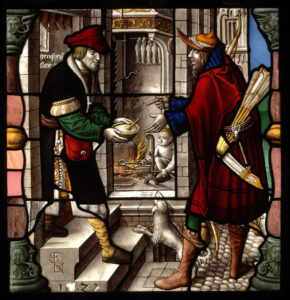Sixth Sunday after Pentecost
10:30 AM • ZOOM Meeting
Study Leader: Mark Biddle
Scripture: Genesis 25:19-34
Theme: “Conflict & God’s Purpose”
https://us02web.zoom.us/j/834854376
If you’d rather join by phone, call: (301) 715-8592
Meeting ID: 834 854 376
In this time of social distancing, we stay connected to one another by gathering virtually in worship to join our voices together in prayer, to fellowship and share with one another, and to explore scripture in an interactive format. Contact Sheryl or the church office if you need help getting ZOOM onto your device.
Artwork: “Mariawald was a Cistercian abbey founded in 1480. The Cistercians were a monastic order established in 1098 in Burgundy at Citeaux. The founder of the Cistercians had broken away from the Benedictines which had been the first monastic order to be established in Europe, in the 6th century.During the Revolutionary struggles in France and the subsequent religious upheavals under Napoleon, many monastic institutions on the continent were ‘secularised’ and their buildings destroyed. The abbey of Mariawald was closed down in 1802 but fortunately its buildings, including the cloisters, remain largely intact. However, the stained glass windows had been removed…Each window had two panels depicting scenes from the Old Testament and two panels with scenes from the New Testament….This type of narrative arrangement is known as ‘typological’. Each Old Testament story was a ‘type’ or a prefigurement of a New Testament story (‘antitype’). The prophets on each window would hold text from the Bible relating to the Old and New Testament stories. For example, this panel shows the Old Testament story of ‘Jacob Tempting Esau’. It was placed in the window just above that of the New Testament scene of ‘The Temptations of Christ. Jacob and Esau were the sons of Isaac. Jacob tempted the hungry Esau with food in exchange for his birthright as the eldest son and heir. This event prefigured that of the devil tempting Jesus Christ with worldly goods.The typological arrangement was popular in the Middle Ages. The stories were reproduced in manuscripts and in engravings from woodcuts and collectively became known as ‘Biblia Pauperum’ (‘Bibles of the Poor’). At the end of the 15th century the Biblia Pauperum were printed in book form and sold in their thousands. These books were used as design sources for artworks including stained glass panels.” [from Victoria and Albert Museum]
Attribution : Rensig, Everhard (possibly) and Gerhard Remisch. Esau Gives Up His Birthright, from Art in the Christian Tradition, a project of the Vanderbilt Divinity Library, Nashville, TN. [retrieved June 30, 2020].
